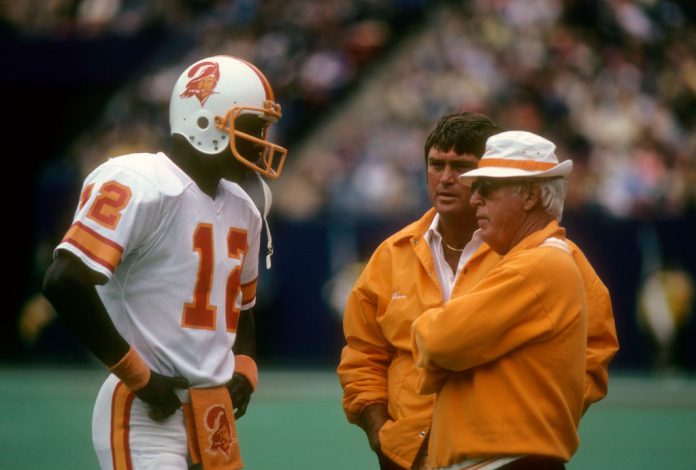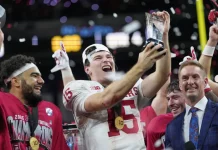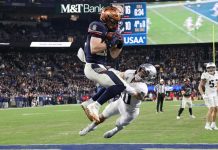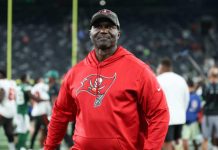
By: Jim Williams Senior Columnist – Capital Sports Network
A Florida Kid, A California Legend, and the Birth of the Buccaneers
The Tampa Bay Buccaneers and Seattle Seahawks were officially awarded as an NFL expansion franchise in 1974, along marking the beginning of professional football in the Tampa Bay area. Over the following year, the organization laid the groundwork for its identity, unveiling the team name, colors, and the now-iconic “Bucco Bruce” logo—a swashbuckling pirate with a dagger in his mouth—designed to reflect the region’s coastal and adventurous spirit. In 1975, the Buccaneers made a bold move by announcing John McKay, the legendary head coach of the USC Trojans, as their inaugural head coach. McKay’s hiring signaled the franchise’s ambition to build a competitive team from the ground up, blending college football prestige with the promise of a new NFL legacy.
I was a 22-year-old sportscaster for WTOG TV in Tampa, covering the inaugural season of the Buccaneers. It was 1976, and the team was brand new. However, for me, the real story wasn’t just the expansion; it was the man leading it: Coach John McKay.
I knew more about McKay than most of the sports writers and broadcasters in the Tampa area. I was a big fan, even though USC was located all the way across the country. But we’ll get to that later. My job was to follow the new expansion team in its first year and provide the viewers with a look at their new pro franchise.
I reported on the Bucs from their first exhibition game in Los Angeles through their early years at home and on the road. McKay’s razor-sharp wit made him a delight for the media and easy to work with once he trusted you.
Tough Times For The Buccaneers At The Start
Many will remember that the Buccaneers lost all 14 games in 1976 and the first 12 games of 1977 before finally winning against the New Orleans Saints. They also clinched the last game of the 1977 season against the St. Louis Cardinals, giving them a two-game winning streak.
I was responsible for postgame interviews, and I told Coach McKay early on that if he didn’t feel like talking, he could just give me a signal—I would then grab a player or his defensive coordinator, Abe Gibron. This simple gesture of respect laid the groundwork for a relationship that would span six seasons and create countless memories.
MUST READS
A First Time NFL Coach Who Became A Winner
McKay was a first-time NFL head coach, fresh off a storied run at USC. The cast of characters at One Buc Place was, at times, a motley crew. But McKay over three years brought structure, wit, and a West Coast swagger to a franchise still finding its footing and a 1979 trip to the playoffs and the NFC Championship against Los Angeles which the Bucs lost at home 9-0.
McKay took the Buccaneers to the NFC Playoffs in just three years and proved he could be a success in the NFL.
How I Became Florida’s Lone USC Fan
Growing up in Tampa, I was a Florida Gator fan by geography—but a USC Trojan fan by heart. I listened to Trojans games on Armed Forces Radio, read McKay’s books, and admired his ability to recruit stars nationwide. I saw him on The Tonight Show with Johnny Carson and the Bob Hope Christmas Special, where he helped introduce the AP College All-Star Team. His charisma was magnetic.
As a high school senior, I wrote him a letter saying, “Coach, I might just be your only USC fan in Florida.” When he left the glitz of Los Angeles for the challenge of building an NFL team in Tampa, it must have been a cultural shock.
During my first meeting with McKay, I mentioned my letter to him and quoted a passage from his book. I asked him what it was like to appear so frequently on The Johnny Carson Show. We talked for an hour, and I didn’t ask a single question about football. At the end of our conversation, I told him that if he ever needed a straight man to set up his jokes, I was available. Over the years, he took advantage of this opportunity in hotel lobbies, much to my delight, and we became friends. I don’t want to give the impression that we were lifelong pals, but we forged a casual friendship that we both enjoyed.
From Sidelines to Studio: The John McKay Show
The first two years, The John McKay Show aired on WTVT and was hosted by their sports director, Andy Hardy. In 1978, WTOG acquired the rights to the preseason telecasts and the McKay Show. At the age of 24, I was named the producer of the preseason telecasts and the producer and feature reporter for The John McKay Show on WTOG-TV Channel 44. We launched the show with Mark Champion—who would later become the radio voice of the Buccaneers—as our first host.
While Champion excelled at breaking down the X’s and O’s, he struggled to draw out McKay’s sense of humor. Champion did an outstanding job as the voice of the Buccaneers for a decade before moving on to become the voice of the Detroit Lions. He was detail-oriented, had a very high football IQ, and was a true professional. However, McKay thrived better with someone who was less of a football expert and more of a straight man.
It was time for a change, and I wanted Jack Harris, the top disc jockey in Tampa, to take over as host. We had worked together before, and I knew he was the right person for the job. Harris had a great sense of humor that could bring out McKay’s personality. We also added a studio audience made up of high school football players from the Bay Area, and things clicked. McKay’s personality shone through. Harris was able to help McKay mix breaking down plays with setting him up for a joke or two.
Meanwhile, he enjoyed discussing football with the high school players. I would pre-tape my segment about behind-the-scenes at the Bucs, and we were fortunate—the fans loved it. More importantly, this new format allowed McKay to showcase his personality instead of just delivering another dry coach’s show.
The Master Class In Football
McKay granted me total access to every coach and allowed me to attend practices. I learned offensive strategies from his offensive coordinator, Joe Gibbs, who would later go on to coach the Washington Redskins and achieve two Super Bowl victories, eventually earning a place in the Pro Football Hall of Fame.
On defense, I was taught by former Chicago Bears head coach Abe Gibron. Gibron played 11 years in the NFL, and after retiring, he served as the defensive coordinator for the Bears under the legendary head coach George Halas. Hall of Fame Bears linebacker Dick Butkus credited Gibron with making him a better player.
I spent time talking to and getting to know players like Doug Williams, the Selmon brothers, LeRoy and Dewey, linebacker Richard “Batman” Woods, and Rickey Bell, to name a few. This access proved invaluable later in my career, and I am grateful to McKay for opening the door and giving me the freedom to learn from some of the best players and coaches in the business.
.
My Favorite John McKay’s One-Liners
On his team’s depth chart: “We have depth. Unfortunately, it’s all at the shallow end.”
On his team’s execution: “I’m in favor of it.” (A question Jack Harris asked him)
After a loss: “We didn’t tackle well today. But we made up for it by not blocking.”
On his kicker’s aim: “I told him to aim for the guy waving the hot dog.”
On emotion in football: “Emotion is overrated. My wife is emotional, but she can’t play football.”
On his team’s performance: “We didn’t do anything well. But we made up for it by doing everything poorly.”
On a player’s injury: “He has a knee injury. He’s out indefinitely. That means we don’t know if he’ll ever play again.”
After All These Years
At the end of the 1981 season, my boss, Jim Dowdle, left WTOG to become the president of the Tribune Company in Chicago and oversee WGN. I soon followed him, leaving Tampa to work for Allie Sherman, a former head coach of the New York Giants, who was then the president of Warner Communications. He was in charge of the USA Network and played a key role in creating programming for pay TV and cable services.
This period marked the beginning of regional cable sports, along with the launch of ESPN, the first 24-hour sports network. Over the next 45 years, I helped create regional sports networks and produced and directed broadcasts for Major League Baseball, the NBA, the NFL, the NHL, and Big Ten football and basketball games of the week, as well as countless other events.
I had the privilege of working with Hall of Fame coaches, managers, players, and broadcasters across all sports. Individuals like Sparky Anderson, Joe Torre, Chuck Tanner, Don Kessinger, Pete Rose, Jim Kaat, Jim Palmer, Willie Stargell, Brooks Robinson, Tim McCarver, Robin Roberts, George Karl, Chuck Daly, Bobby Knight, Bill Cowher, Jimmy Johnson, and Bobby Bowden, to name a few, were all wonderful to me.
They provided me with access and insight into how they coached, managed and played for their teams, but none were quite like John McKay. (Bowen was a close second.) It was during those early days working with Coach McKay, who was truly a one-of-a-kind personality, that I experienced kindness when I least expected it. He was not just a coach; he was a character. For that, I will be forever grateful as we celebrate 50 years of Buccaneers football.






